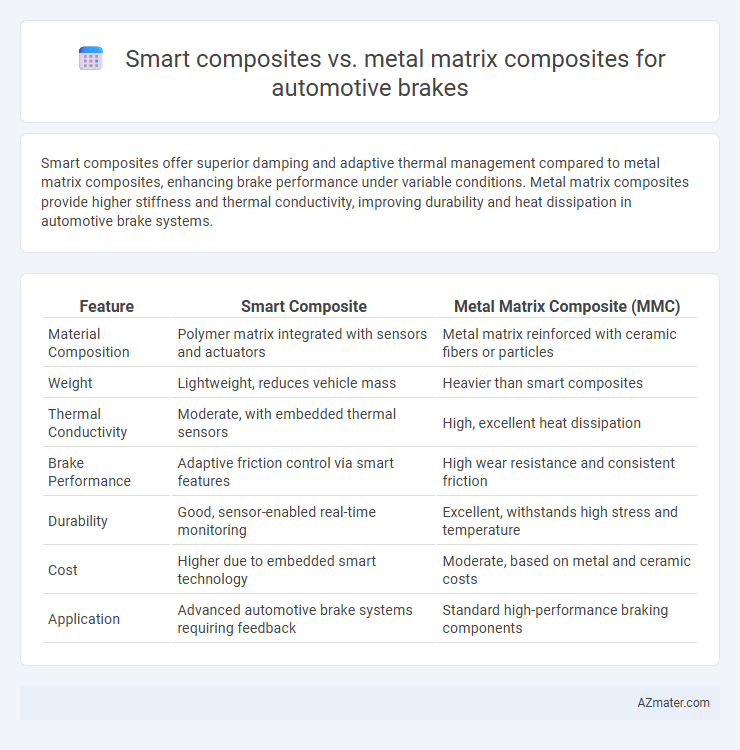Smart composites offer superior damping and adaptive thermal management compared to metal matrix composites, enhancing brake performance under variable conditions. Metal matrix composites provide higher stiffness and thermal conductivity, improving durability and heat dissipation in automotive brake systems.
Table of Comparison
| Feature | Smart Composite | Metal Matrix Composite (MMC) |
|---|---|---|
| Material Composition | Polymer matrix integrated with sensors and actuators | Metal matrix reinforced with ceramic fibers or particles |
| Weight | Lightweight, reduces vehicle mass | Heavier than smart composites |
| Thermal Conductivity | Moderate, with embedded thermal sensors | High, excellent heat dissipation |
| Brake Performance | Adaptive friction control via smart features | High wear resistance and consistent friction |
| Durability | Good, sensor-enabled real-time monitoring | Excellent, withstands high stress and temperature |
| Cost | Higher due to embedded smart technology | Moderate, based on metal and ceramic costs |
| Application | Advanced automotive brake systems requiring feedback | Standard high-performance braking components |
Introduction to Automotive Brake Material Innovations
Smart composites in automotive brake systems integrate sensors and adaptive materials to enhance performance, offering real-time monitoring and improved thermal management. Metal matrix composites (MMCs), typically aluminum or magnesium reinforced with ceramic particles, provide superior strength-to-weight ratios and excellent wear resistance under high temperatures. Innovations in brake materials emphasize combining smart composite technology with MMCs to achieve lightweight, durable, and responsive braking components that meet increasing safety and efficiency demands.
Overview of Smart Composites in Brake Systems
Smart composites in automotive brake systems integrate sensors and actuators within composite materials to enable real-time monitoring and adaptive response to braking conditions. These materials enhance performance by providing self-diagnostic capabilities, improved wear resistance, and optimized thermal management compared to traditional metal matrix composites. Incorporating piezoelectric fibers or carbon nanotubes allows smart composites to adjust friction levels dynamically, increasing safety and durability in high-performance braking applications.
Metal Matrix Composites: Definition and Applications
Metal Matrix Composites (MMCs) are engineered materials combining metal alloys with ceramic or fiber reinforcements to enhance mechanical properties such as strength, wear resistance, and thermal conductivity. In automotive brake systems, MMCs provide improved performance by offering lightweight solutions with superior heat dissipation and durability compared to conventional metals. Their applications include brake rotors and pads where high thermal stability and enhanced frictional characteristics are critical for safety and efficiency.
Comparative Mechanical Properties of Both Materials
Smart composites exhibit higher specific strength and improved wear resistance compared to traditional metal matrix composites (MMCs), making them ideal for automotive brake applications requiring lightweight yet durable materials. MMCs generally offer superior thermal conductivity and stiffness, crucial for effective heat dissipation during braking but tend to be heavier and less adaptable to complex shapes. The enhanced fatigue resistance and tunable properties of smart composites contribute significantly to prolonged brake component lifespan and improved overall vehicle performance.
Thermal Performance in High-Stress Braking
Smart composites offer superior thermal conductivity and heat dissipation compared to traditional metal matrix composites in high-stress automotive braking applications. Their enhanced microstructural design enables better resistance to thermal degradation and reduced brake fade under intense, repeated braking cycles. Metal matrix composites provide structural strength but often suffer from lower thermal stability and slower heat transfer, limiting performance in extreme thermal conditions.
Weight Reduction and Fuel Efficiency Impacts
Smart composites in automotive brakes offer significant weight reduction compared to traditional metal matrix composites (MMCs), enhancing overall fuel efficiency by lowering vehicle mass and improving energy consumption. The advanced fiber-reinforced smart composites provide superior stiffness-to-weight ratios, reducing unsprung weight and enabling better braking performance with less fuel usage. Metal matrix composites, while durable and high-temperature resistant, generally exhibit higher density, limiting their effectiveness in maximizing weight savings and related fuel efficiency gains.
Wear Resistance and Service Life Analysis
Smart composites in automotive brakes offer enhanced wear resistance through self-healing capabilities and adaptive friction properties, outperforming traditional metal matrix composites (MMCs) that rely on static reinforcement particles like silicon carbide or aluminum oxide. MMCs provide high thermal conductivity and structural strength, yet their wear resistance often degrades over time under extreme frictional stress, shortening service life compared to smart composites. Service life analysis reveals smart composites maintain consistent braking performance and reduced material degradation, leading to longer maintenance intervals and improved safety margins in automotive applications.
Cost Implications in Manufacturing and Maintenance
Smart composites in automotive brakes offer cost savings during manufacturing due to lower material and processing expenses compared to traditional metal matrix composites (MMCs), which require high-temperature sintering and complex machining. Maintenance costs for smart composites are reduced by their enhanced resistance to wear and corrosion, leading to longer service intervals and lower replacement rates. Despite a higher initial price for some smart composite variants, total lifecycle costs remain competitive when factoring in decreased downtime and improved brake performance.
Environmental Sustainability Considerations
Smart composites in automotive brakes offer enhanced environmental sustainability by incorporating lightweight, recyclable materials that reduce vehicle weight and improve fuel efficiency, thereby lowering carbon emissions. Metal matrix composites (MMCs), while providing superior thermal conductivity and wear resistance, often rely on energy-intensive production processes and non-recyclable metals, limiting their eco-friendly potential. Advances in smart composite technologies prioritize eco-design principles, including the use of bio-based resins and non-toxic reinforcements, contributing to reduced lifecycle environmental impact compared to traditional MMC brakes.
Future Trends in Automotive Brake Material Development
Smart composites in automotive brakes integrate sensors and adaptive materials to enhance performance, enabling real-time monitoring and improved safety. Metal matrix composites (MMCs) offer superior thermal conductivity and wear resistance, making them ideal for high-performance braking systems. Future trends emphasize the development of multifunctional smart composites with embedded electronics alongside lightweight MMCs to achieve enhanced durability, reduced weight, and advanced braking control in electric and autonomous vehicles.

Infographic: Smart composite vs Metal matrix composite for Automotive brake
 azmater.com
azmater.com